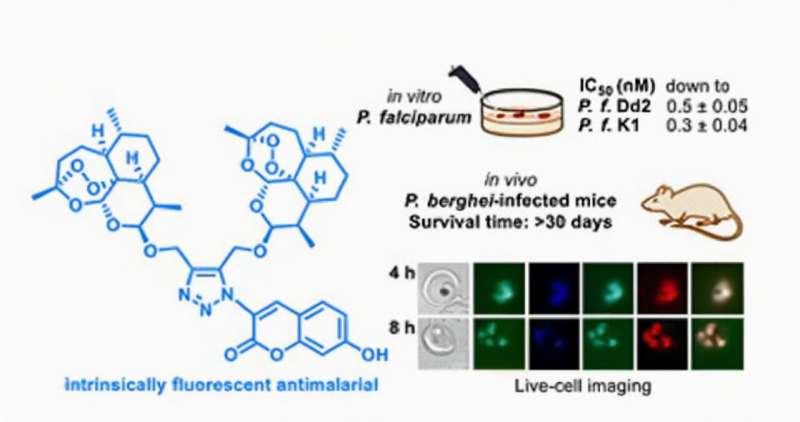This article has been reviewed according to Science X's editorial process and policies. Editors have highlighted the following attributes while ensuring the content's credibility:
fact-checked
peer-reviewed publication
trusted source
proofread
New approaches in the fight against drug resistance in malaria

Malaria is one of the most widespread and deadly infectious diseases worldwide. New compounds are continuously required due to the risk of malaria parasites becoming resistant to the medicines currently used. A team of researchers at FAU, led by Prof. Dr. Svetlana B. Tsogoeva, has now combined the anti-malaria drug artemisinin with coumarin—which, like artemisinin, is also found in plants—and the researchers developed an auto-fluorescent compound from both bioactive substances.
This autofluorescence is particularly advantageous as it can be used for imaging in live cells and shows how the medication works in a precise time sequence. The working group also discovered that the autofluorescent artemisinin-coumarin hybrids are able to destroy a certain drug-resistant malaria pathogen called plasmodium falciparum. They have published their findings in the journal Chemical Science.
Artemisinin is a highly-effective and common ingredient for the manufacturing of malaria medication gained from a plant called sweet wormwood (Artemisia annua L.). Coumarin is a secondary plant compound found in various plants. In the development of drugs against malaria, active substances are labeled with fluorescent substances in order to identify how they act against malaria pathogens in precise chronological order using imaging techniques. This fluorescent labeling has already been used with artemisinin.
Combining substances to achieve autofluorescence
A significant disadvantage of labeling with fluorescent substances is the fact that they alter how the medication works. For example, this means that in certain circumstances cells infected with malaria absorb a drug like artemisinin differently after fluorescent marking than previously.
The solubility of the drug can also change. This was avoided by the development of autofluorescent hybrids, which are compounds made of two or more basic compounds that are inherently fluorescent and whose mode of action can be precisely observed using imaging techniques.
Active agent with special skills
The research team, led by Prof. Tsogoeva at the Chair of Organic Chemistry I, decided to combine artemisinin with bioactive coumarins because coumarin derivatives also possess anti-malaria properties. They can also be easily chemically altered so that they become extremely fluorescent.
The researchers discovered that it was not only possible to observe the mode of action of this first autofluorescent artemisinin-coumarin hybrid in living red blood cells infected with P. falciparum. In conjunction with Prof. Barbara Kappes (Department of Chemical and Biological Engineering, FAU) and Dr. Diogo R. M. Moreira (Instituto Gonçalo Moniz, Fiocruz Bahia, Brazil), they also discovered that the active agent was highly effective against P. falciparum strains in vitro (in a test tube) that are resistant to chloroquine and other malaria drugs. Above all, however, the new compound also proved highly effective against the malaria pathogens in vivo in mouse models.
With the creation of the first autofluorescent artemisinin-coumarin hybrid, the FAU researchers hope that they have laid the foundation for the development of further autofluorescent agents for treating malaria, and have made significant process in overcoming multi-drug resistance in the treatment of malaria.
More information: Lars Herrmann et al, Autofluorescent antimalarials by hybridization of artemisinin and coumarin: in vitro/in vivo studies and live-cell imaging, Chemical Science (2023). DOI: 10.1039/D3SC03661H



















